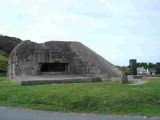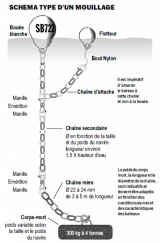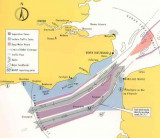

Antifer
Cap d'Antifer Port pétrolier du Havre - AntiferDans cette zone se trouvent las plages du débarquement du 6 Juin 1944.
| Latitude | Longitude | |
| DMS | --- | --- |
| DM | --- | --- |
| DD | --- | --- |


 La Manche est une branche de l'océan Atlantique qui sépare la Grande-Bretagne du nord de la France.
De grandes îles sont situées dans la Manche comme l'île de Wight au large de la côte anglaise les Îles anglo-normandes au large des côtes de la France. Le littoral, en particulier sur la rive française, est profondément échancrée comme la péninsule du Cotentin en France qui s'avance dans la Manche . Au nord de l'île de Wight se trouve le canal de Solent.
La Manche est une branche de l'océan Atlantique qui sépare la Grande-Bretagne du nord de la France.
De grandes îles sont situées dans la Manche comme l'île de Wight au large de la côte anglaise les Îles anglo-normandes au large des côtes de la France. Le littoral, en particulier sur la rive française, est profondément échancrée comme la péninsule du Cotentin en France qui s'avance dans la Manche . Au nord de l'île de Wight se trouve le canal de Solent.  The English Channel (French: La Manche, "the sleeve") is an arm of the Atlantic Ocean that separates the island of Great Britain from northern France.
The English Channel (French: La Manche, "the sleeve") is an arm of the Atlantic Ocean that separates the island of Great Britain from northern France.Currents
As the English Channel is entered, and the
fairway narrows, the rotatory currents of the approach become gradually
more and more rectilinear. The rates of the currents in the fairway
vary with the width, and are greatest in the narrowest parts.
In the
middle of the fairway, between Bill of Portland and Saint Catherine’s
Point, on the English coast, and Cap de la Hague and Pointe de Barfleur,
on the French coast, currents attain rates up to about 3.5 knots at
springs. In the widest parts, currents seldom attain rates exceeding
2.5 knots at springs.
Although the surface current has a dominant NE
and E directional set, it is influenced significantly by the wind, which
is variable in direction during all seasons, although W winds
predominate.
The prevailing direction of the North Atlantic current
is therefore likely to be most in evidence after strong and long
continued SW or W winds.
The time of HW changes rapidly along the
French coast, and is about 6 hours later at Le Havre than at lle
d’Ouessant. The time at which the tide turns usually differs
considerably from the time of local HW. The flows, therefore, cannot be
described as “flood” and “ebb”, and are usually termed E and W. However,
it must be understood that the E current is that which runs up the
Channel, from the Atlantic towards Dover Strait, and the W current that
which runs down the Channel, from Dover
Strait towards the Atlantic.
The actual directions of the currents are reported to differ considerably from E or W. In the estuaries and rivers, currents are usually called the “incoming” and “outgoing” but may be referred to as flood and ebb. Among the Channel Islands, the times and directions of the flow differ greatly from those in the fairway of the English Channel. Therefore, care is required when approaching the above localities. The tidal flows at locations to the W and NW of Ile d’Ouessant are significantly affected by current due to the prevailing wind.
Extract from NGA / UKHO sailing directions documents
Ebook | Manche - English Channel
|









